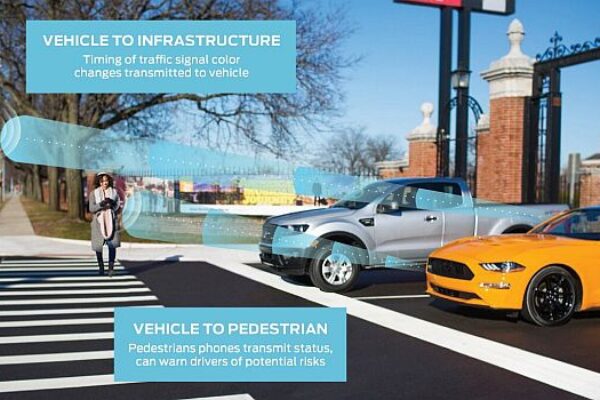
Ford commits to ‘talking’ and ‘listening’ vehicles in 2022
C-V2X enables equipped vehicles to “talk” to and “listen” for similarly equipped vehicles, people, and traffic management infrastructure such as traffic lights to relay important information and help make city mobility safer and less congested. Planned alongside the rapidly building 5G cellular network, C-V2X enables direct communication between connected devices without requiring a signal to first travel to a cellular tower, allowing vehicles to quickly send and receive information.
Ultimately, says the company, it lets drivers know what’s ahead of them even before they have to encounter it. Examples include navigating four-way stops, where vehicles will be able to communicate with each other to negotiate which one has the right of way, and accidents, where a car that’s involved in an accident can relay its status to approaching vehicles.
Similarly, a pedestrian equipped with a mobile phone could convey their location to vehicles, ensuring that everyone on the road is aware of people who may be out of their direct line of sight. Looking further out, says the company, cities could even use the technology to enable smart vehicles to “talk” to smart traffic management systems to create better flowing transportation systems.
“Our move to deploy this technology builds on our prior commitment to equip every model we release in the United States with conventional cellular connectivity by the end of 2019.” says Don Butler, executive director, Ford Connected Vehicle Platform and Product. “C-V2X will work with Ford Co-Pilot360, our advanced suite of driver-assist and safety features standard across North America on new passenger cars, SUVs, and trucks, including F-150, going forward.”
With plans to roll out 5G cellular networks underway, says the company, C-V2X can complement the sensors of self-driving cars by adding to their comprehensive view from LiDAR, radar, and camera sensors. For example, emergency vehicles equipped with C-V2X transmitters could notify self-driving vehicles on their route so the vehicles could pull over or reroute in plenty of time. Self-driving vehicles could even get real-time updates on road conditions that affect their routes.
“A conducive regulatory environment must be in place for C-V2X to be deployed, which is why we are working just as much with industry and government organizations to create such a technology-neutral environment,” says Butler. “This technology will only live up to its full potential if many vehicles on the road as well as roadside infrastructure take advantage of it. That’s why we are inviting other automakers, infrastructure, and road operators, as well as government agencies, to work with us to accelerate momentum for C-V2X.”
“Billions of dollars already are being spent as the cellular industry builds 5G networks,” Butler adds, “so we think the timing is perfect to give our vehicles some of the natural skills we use every day to get around.”
Related articles:
Interoperability of C-V2X signals between Ford and Audi demonstrated
C-V2X commercialization imminent
Cellular V2X trials to start in California
 If you enjoyed this article, you will like the following ones: don't miss them by subscribing to :
eeNews on Google News
If you enjoyed this article, you will like the following ones: don't miss them by subscribing to :
eeNews on Google News




